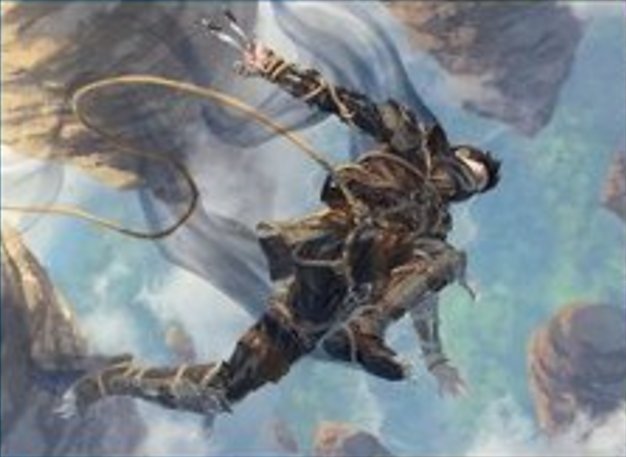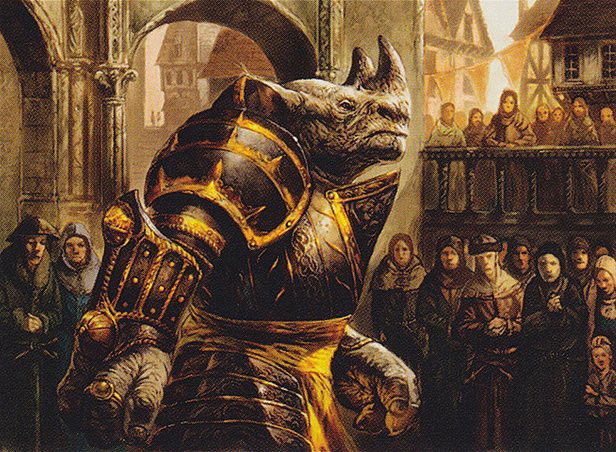Hello my dears, I'm Betão and today I come to bring a deck tech, which will follow a pattern from now on. Whenever I bring the story of a deck, later, I will bring its deck tech. You can see it here, The History of Tron.
We name here as Flicker Tron, all the decks that base their game plan on blinking their creatures, in order to recycle their resources, such as Rainbow Tron, Murasa Tron, Fog Tron and etc. Unlike the Temur Tron, the big creatures Tron, as well as the Tron formed by colorless spells and artifacts and the new Cascade Tron, which base their strategy on casting high and powerful CMC cards.
The list of which the deck tech is constructed, has been developing with new cards, and seeking to exploit to the maximum its greatest powers.
Here is the list:
Without further ado, let's start our deck tech.
Lands
Starting with the lands that makes a Tron, the Urza's lands:

These are lands that generate only one colorless mana each. However, if the player controls at least one copy of each, Urza's Tower will generate three colorless mana, the other two Urza's lands will generate two colorless mana each one.
And for those who still don’t know what that amount of potential mana means, it will simply allow you to cast lots of spells in a single turn, sometimes up to three times the opponent, and also high CMC creatures of relevance to the deck, and that normally other decks would not be able to.
But beware of all this power, for the advantage of manas built throughout the game does not make you greedy, casting too many spells and end it up all tapped and exposed, with no answers, especially removals. The Tron player's tempo, that is, his time, is very important to achieve victory, and this is acquired with time, experience, among other attributes that we will see ahead.

This is a great resource against decks that interact with the graveyard, like Tron himself, also against Boros Bully, who has some flashback cards, besides, of course, decks better known for this type of interaction, which are outside of the online metagame, but can be faced at any time, whether in online leagues, independent circuit tournaments, and even in the LGS. They are the Reanimator and the UB Exhume.

Here we only use one copy, but the deck can adjust itself very well to add more copies. It's a land that generates colorless mana, with the ability to filter a color, according to what the moment needs. It also allows you to place two +1/+1 counters on the target creature, which will usually be a Mulldrifter, making it a great win condition. You can return to the hand with Pulse of Murasa too and repeat the process.

It enters tapped, but its the ideal on turn 1, as the player needs to generate colored mana early in the game, for counters or fogs. The Weather the Storm is also important in turn three or four, if the opponent is a Burn. The life gained is a welcome bonus.

This is another land that gives life. It's from the same cycle as the previous one, so it will also enter tapped, but unlike the other, in addition to blue mana, you can choose the color red and not green. It's on the deck due to Fiery Cannonade and Pyroblast, besides of course Gorilla Shaman in game two.

Extremely useful and very important in decks with three or more colors, because in addition to generating blue, it generates another color that the controller will choose when it's entering the battlefield. It has synergy with the deck theme, as it can blink with the Ghostly Flicker and change the secondary color if needed. The only disadvantage is that it also enters tapped.
Finally, a copy of Island, adaptable of course. Important against some decks in game two, to cast responses right away with Hydroblast and Dispel, without the need of waiting 1 turn to untap a land that enters tapped.
Artifacts

With a total of four copies, for two manas, the player has a mana filter in the battlefield, besides the "draw a card" ETB effect. It can also be target of Flicker, because of it's card advantage ETB.

This is a ramp, that generates any of the five colors of Magic. With four copies in the deck and three to cast, it has, besides the banefit of ramping, the effect of tap, pay four manas and draw a card. All the players that control a Bonder's Ornament draw a card, but in the actual meta, we don't have much decks that uses it, it's not a problem. This is the preferred play to do when the priority is passed to the Tron player on the beggining of the opponent's end step.
Creatures
All creatures on the main deck have effects that trigger when they enter the field, called ETBs, and this is the main strategy of the deck.

It only takes one copy, but some decks may choose not to use it, or even include more copies. With a toughness that resists a Lightning Bolt, when entering the field, the target opponent skips the next combat phase. This effect is cumulative, so you can make your opponent skip many combat phases. Excellent against aggressive decks, obviously, but against decks that have Monarchs, once Tron steals the crown, if he cannot beat, he cannot steal back, unless he casts another Monarch, but that can be countered.

Uses one copy too. It's ETB returns one of the opponent's threats to the hand, which can be a land as well, and forces that opponent to discard a card. Very good toughness and power that allows you to attack efficiently when the game is more controlled. Think that if you return a land to your opponent's hand, at a certain point in the game, he will need to choose between keeping the land or some resource in hand. With few lands in the battlefield, the use of these resources will be limited.

Its interaction with Ephemerate is already well known, casting it by Evoke and, after the draws, target the flying fish with the aforementioned Ephemerate. Four cards for four manas, reaching six in two turns. But it's not just drawing cards, it's an excellent blocker for fairies, as well as evasively hitting on decks without flying creatures. The Cave of Temptation can give it an extra power at the late game against these decks.

It is the pillar of the deck, and many people question whether the adequate quantity would be two or three copies, due to its importance. Here we use three copies. If the list uses more than two copies of Pulse of Murasa, then you can use two walls. This creature that allows the deck to exploit its power to the fullest, helps to reuse instants and sorcery spells, and to return Ghostly Flicker to hand, even though his second target may have been a Dinrova or Stonehorn, some land (like Bojuka to exile the opponent's graveyard or a Thriving Isle, to change its second color), and even the Prism, to draw another card, and leave the filter untapped. In addition to its ETB effect, it is a wall with excellent toughness, and is beyond the damage of Cannonade and Lightning Bolt.
Other Spells
Drop One

Theoretically, this counter is drop one, but it needs X to be paid, unless you just want to use the scry 2, an important addition to the deck. However, it is unusual to use it that way. As a counter, what it really is, is great, since it counters any kind of spell, and the necessary X will almost always be unattainable by the opponent.

Two copies are used. It is a good defense against removals, and will still trigger the ETB of the creature to be protected, and reuse in the upkeep of the next turn, triggering some creature again. You can have an infinite cycle with Mnemonic Wall in the battlefield, blinking the wall itself, in order to reuse other spells, repeating the process whenever necessary.

A card that came back to stay after a period of little use, at least on Flicker Tron decks. It searchs for land and put it on the battlefield, and the advantage is that it is instant, which also allows you to bring Bojuka Bog. The disadvantage is that you need to sacrifice land as part of the cost of the spell, and of course, sacrifice one that is tapped. This disadvantage is perhaps not so significant, since with Pulse of Murasa you can return the sacrificed land from the graveyard.

The slot occupied by this counter/removal is flexible. However it has been used to strengthen the deck against another Tron and, more recently, against the UX decks, which are stronger, mainly due to the addition of Fall From Favor.
Drop Two

Essential in the deck, since most spells that threaten Tron and need to be countered, cost two or less, and a small part of cost three. It will also not be a problem for the deck to pay two extra mana.

Key card against aggressive decks, essential that it comes in the starting hand against these decks. Prevents combat damage, and allows you to flashback it. Another important function is when Tron's player is the Monarch, he will prevent the damage, consequently, he will prevent the opponent from stealing the crown.

The best cantrip for Tron today, being the only one on the deck. Very important in the starting hand for "digging" resources needed to stay alive in the early game, and also finding the pieces to gather the Tron together as soon as possible.

It allows many life points to be gained in a short time. Excellent against decks that cause direct damage, mainly Burn, and against aggros decks it is also efficient. Since most decks use either combat or direct damage as the main Win Condition, gaining a lot of life at any time of the game can frustrate opponents' plans.

The best finisher on the deck. The most used strategy is to stabilize and control the early and mid game until you get lots of lands, and finish it with a big Thunder. Due to the possibility of reusing resources in the graveyard, besides being a finisher, it is a great "mass removal".
Drop Three

Returning a land or creature and still gaining six life points is very important on this deck. Synergistic with the alternative cost Evoke of Mulldrifter and also with Crop Rotation. Life gain is vital in some points of the game, and can define victory or defeat in several matches.

It's a counter capable of untap lands. Your most powerful use will be counter a spell on opponent's turn and cast a Teachings or a Weather the Storm after untapping the lands.

This recent addition to Pauper could undermine the plans of many aggressive decks like Stompy, and will also cause serious problems for Fairy-based UX. It's a great mass removal, and Pauper was in need of something in that segment.

One of the pillars of the deck. The fact that two targets are chosen, allowing infinite looping, makes it essential and it is that card that needs to come right into the hand. For this purpose we have cantrips and cards that generate card advantage, in addition to the Teachings tutor. Targeted in lands like Bojuka and Thriving, they are obviously useful, as well as in Prism.
Drop Four

The tutor of this deck, that is, searchs the deck's instant spells. Believe that searching Teachings with Teachings is a great move, as it has a flashback, and the deck also has ways of reusing the resources previously used. With greater reach of the main instant spells, this, despite not being one of the pillars of the deck, is undoubtedly one of the best cards in this list.
Maybeboard

These three cards have been part of Tron's main deck in the past, and in some lists, still use one or the other. However, in the current meta, they are being increasingly left aside.
Both Compulsive Research and Forbidden Alchemy are cantrips that feed the graveyard and a card select, but the first is also an alternative wincon, mainly against Elves.
The Dispel is a faster, instant spell, commonly called "counter of counters".
Honorable Mention
Using this term by Alexandre Weber again (3 times brazilian National Pauper Champion), it is necessary to highlight a common card that is not used, in fact it is almost despised by the Pauper community, at least in the competitive scenario, but that deserves defense.

The Rhystic Study is a card with absurd effect, it is a staple in Commander format and certainly in the PDH. But although common, and obviously valid at Pauper, it is little used. But what would be the reason?
It increases the cost of all spells that the opponent will cast in a generic mana, and this greatly limits what the opponent will actually do with his spells. If the opponent does not want to pay extra mana for spells, simple the controller of the aforementioned enchantment can draw a card, and this is a card advantage, and on control decks like Tron, it is essential to develop your game, even more in this deck that generates a lot of mana.
So here's the tip for at least testing this card.
As stated, the deck focuses on initial survival, so there is no need to despair to get the three pieces of Tron as fast as you think necessary. The second step is to create an advantage and dominate the field, then finish the game safely.
Important Tip
As mentioned in the beggining, be careful with the greed. The possibility of casting even three times the number of spells your opponent can cast in a single turn, does not means that you HAVE to do that. Good Tron players are known by having a "good click", that means, they know the right moment to cast their spells and save lands to generate mana in response to possible threats of the opponent.
This "feeling" the playr acquire with experience, lots of training and lots of study of the deck.
This was Tron's deck tech. Right after, there is a side tech along with a side guide.
I hope you enjoyed reading, thank you and see you next time.













— Kommentare 0
, Reaktionen 1
Sei der erste der kommentiert